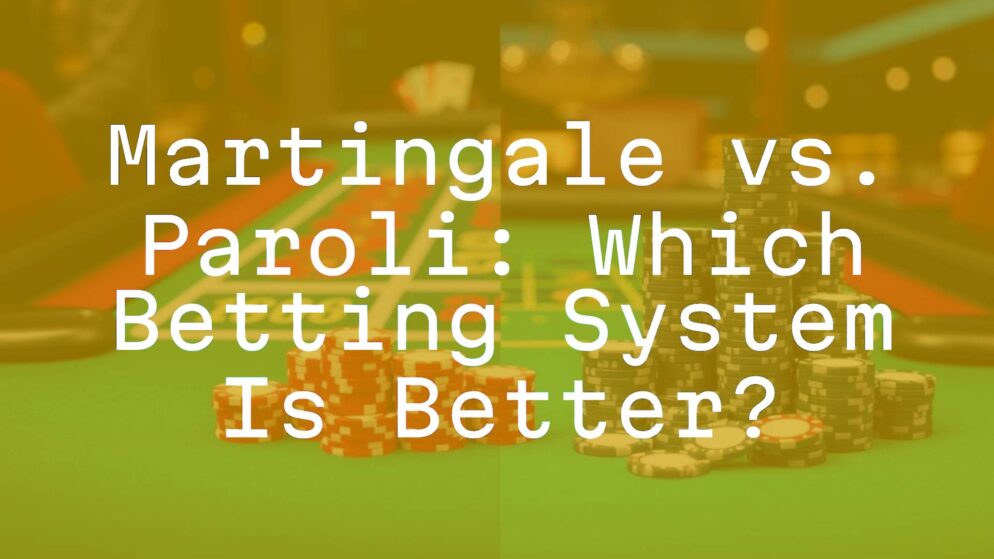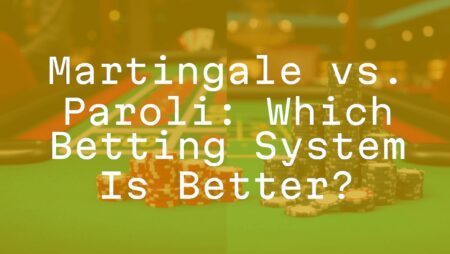

People have always tried to find ways to beat the odds in gambling, and over time, many have turned to betting systems to help them do so. Two of the best-known systems are Martingale and Paroli. But which of these actually gives players an advantage? The truth is, neither the Martingale nor the Paroli system changes the basic odds of any casino game. Both are about adjusting your bets in a certain pattern, not overcoming the casino’s in-built advantage. The house edge always stays the same, no matter which method you follow. These systems may feel different in terms of risk and possible rewards, but the casino’s mathematical benefit is always there.
Why Are Betting Systems So Popular?
Betting systems are popular because they give players a sense of order in an unpredictable setting. For anyone who likes to gamble, the idea of following a structured betting plan can feel reassuring. A system offers clear rules to follow, so you don’t just bet randomly. Many gamblers hope using a system will help them beat the odds, but the reality is that the house always has the edge-payoffs are never perfectly even with the real odds. This means that over time, even betting on 50/50 outcomes, most players will lose. What betting systems do is try to manage the money you risk and win, not make the game winnable in the long run.

Another reason these systems are popular is that they guide players to act less on impulse and stick to a plan. Even though these systems don’t change the odds of games like roulette or baccarat, they can help people manage their bankroll and have a clear way to bet. The sense of following a plan, even if it doesn’t promise long-term profits, is a big reason why these systems keep attracting gamblers.
Do Martingale or Paroli Affect the Odds?
No matter how many people believe in them, Martingale and Paroli can’t change the payout odds or lower the house edge. The real chances in games like roulette or blackjack always stay the same. For example, in European roulette, betting on red or black only gives you about a 48.6% chance because of the green zero space; it’s not quite a 50/50 wager. To break even, you’d have to win half the time, but the house edge stops that from happening.

These systems only change how much you bet after you win or lose. They’re designed to help you possibly get back losses or try to make more money on streaks of wins. In short, they help manage your bankroll; they don’t change the odds or make you more likely to win in the long run. Even with a smart plan, the randomness of casino games means no system will give players a true mathematical advantage.
History of the Martingale and Paroli Systems
Many betting systems, including Martingale and Paroli, have been around for centuries. Their long history is closely tied to the early days of probability theory and shows that people have always looked for ways to manage chance and risk in gambling.

Where Did the Martingale Idea Come From?
The Martingale is a simple and familiar betting idea. Its roots are sometimes linked to the famous French thinker Blaise Pascal, who laid the groundwork for modern probability with Pierre de Fermat in the 1600s. While Pascal didn’t invent the Martingale as we use it today, the idea of using math and logic to try to beat games of chance started with thinkers like him.
The name “Martingale” likely came from a kind of betting done in France in the 1700s. The key idea is simple: double your bet after each loss. If you eventually win, you recover all your losses and gain a little extra. This rule has stuck around for hundreds of years because it’s easy to remember and gives players hope, even though it’s risky.
How Was the Paroli System Developed?
The Paroli is often called the “Reverse Martingale.” Some say it began in Italy in the 1500s, around the same time as the early work on probability in France. If it really came from the same line of thinking, it’s been used for centuries. While Martingale is about chasing losses, Paroli is about kaking the most of winning streaks-it tells you to increase your bets after a win, not after a loss. It comes from the same urge to try to use math and structured betting to beat chance, even though the underlying odds remain the same.
How the Martingale System Works
The Martingale is probably the world’s most famous betting system. It is easy to understand and is called a “negative progression” system, which means you increase your bet after losing. The whole idea is to recover any lost money with one eventual win, making a small profit.
Martingale Rules: Step by Step
- 1. Choose Your Base Bet: Decide on your starting “unit”-often the table minimum.
- 2. Place Your First Bet: Bet your base unit amount.
- 3. If You Win: Stay with the base unit for your next bet. Each win gives you a small profit.
- 4. If You Lose: Double your next wager (e.g., $1, lose, then bet $2; lose again, then bet $4, etc.).
- 5. After a Win: A win after doubling recoups all losses with a profit equal to your starting unit. For example, if you bet $1 and lose, then $2 and lose, then $4 and win, you’re back to even and up $1.
- 6. Reset: Go back to your starting bet after each win.

Martingale seems unbeatable if you have unlimited money and no bet limits. The thinking is that eventually, a win will wipe out all past losses and put you ahead by your base unit.
Weaknesses and Drawbacks of Martingale
There are some major problems with Martingale in real life:
- Money Needed: Even starting small, a string of losses means you must keep doubling your bets. After eight losses, your next bet could be $256 if you started at $1. Few people want or can afford to keep going at that level.
- Table Limits: Casinos set maximum bet amounts. If you hit the limit, you can’t double anymore, making it impossible to recover your losses in the way the system expects.
- Big Risks for Small Wins: You risk more and more money just for a small profit each time. The risks grow fast, and the rewards do not increase to match, making this a very risky strategy.
- No Change to House Edge: This system does not make the odds any better for you. The casino’s advantage stays the same.
How the Paroli System Works
Unlike the Martingale, the Paroli system is a “positive progression” approach. It asks you to raise your bet size after wins, not after losses. This system looks for winning streaks and tries to make the most of them, all while limiting how much money you risk.
Paroli Method: How It Works
- 1. Pick a Base Bet: Choose a small, affordable bet to start with (like 1% of your total bankroll).
- 2. Start with the Base Bet: Bet this amount on a near 50/50 bet, such as red or black in roulette.
- 3. If You Lose: Keep the bet at the base amount. Don’t try to recover with bigger bets.
- 4. If You Win: Double your bet for the next round. This way, you are risking the money you just won, not your original money.
- 5. Three-Win Rule: The classic system says to stop doubling after three wins in a row. At this point, go back to your starting bet, pocket your profits, and repeat.

With Paroli, your bigger bets use “house money” (your winnings), not your own. Losses never get out of hand because you never chase them by betting more after losing.
Problems and Flaws in Paroli
- Missed Big Runs: The three-win rule means you might not make the most of long winning streaks. If you reset after three wins, but the streak keeps going, you could’ve won more by continuing.
- Discipline Needed: Some players can’t resist going past the three-win rule and end up losing what they have just won.
- Still No Change to House Edge: Like every betting system, Paroli can’t beat the basic odds. The casino’s advantage stays the same.
- Table Limits: If you go on a long winning run, doubling your bet each time can eventually bump into the casino’s maximum bet, stopping the streak.
Martingale vs. Paroli: The Key Differences
| Feature | Martingale | Paroli |
|---|---|---|
| Progression Type | Negative (double after a loss) | Positive (double after a win) |
| Risk Level | High-can quickly exhaust bankroll | Low-risk is mostly limited, losses are controlled |
| Bankroll Needed | Large, due to fast escalation during losing streaks | Modest-bigger bets use winnings, not your own funds |
| Handling Losing Streaks | Double up, high risk of wiping out | Stick to small bets, minimize risk |
| Handling Winning Streaks | Profit per win is always the base unit | Build up profits across winning streak, then cash out and reset |
| Effect on House Edge | None | None |
Pros and Cons of Martingale and Paroli
Martingale: Main Advantages and Risks
- Pros:
- Very easy to use and understand
- Seems to offer a guaranteed win after every losing streak (in theory)
- Simple rules make it appealing to newcomers
- Cons:
- Can burn through your bankroll quickly if you hit several losses in a row
- Table limits will prevent you from always being able to double your bet
- You risk a lot of money just to win a very small amount
- Does not improve your odds against the casino
Paroli: Main Advantages and Drawbacks
- Pros:
- Good for players who want to protect their bankroll
- Losses stay small-even during bad streaks
- Only increase bets with money you’ve already won
- Structure makes it easier to quit ahead
- Cons:
- Resets after three wins may miss out on bigger streaks
- Requires discipline to stick to the plan
- No improvement to your long-term chances
- Still possible to lose winnings if you don’t stop as suggested
Which System Should You Use?
Short Sessions vs. Long-Term Play
- Martingale: If you like to gamble in short bursts and want the chance to quickly recover small losses for a small profit, Martingale may fit those rare, quick sessions. But the risk goes up the longer you play, making this a risky choice for continued play.
- Paroli: If you prefer playing longer sessions and want to make your money last, Paroli fits better. By not increasing bets after losses, you protect your bankroll and can enjoy gambling for a longer time.
Risk-Tolerant vs. Careful Players
- Martingale: Best for players who like taking big risks and don’t mind chasing losses for the thrill, as long as they accept the real chance of major losses.
- Paroli: Better for careful players who want to avoid large swings and want their money to last. Paroli helps you limit losses and take advantage of the occasional lucky streak.
Which Fits Your Style?
- If you want fast action and are okay with possible big losses, Martingale might seem fun-but be cautious.
- If you want to play for enjoyment, preserve your budget, or simply want more control, Paroli is a safer pick.
- Remember, neither system guarantees you’ll win. The house always has an edge, and no method can change that fact.

Common Questions about Martingale & Paroli
Can You Beat the Casino Long-Term with Either System?
No. Both systems give structure to your bets, and you might win in the short term, but over the long run, you can’t beat the house edge. Both systems work inside games designed to favor the casino, and using them doesn’t change the odds in your favor over time.
Are These Systems Allowed in Casinos?
Yes, both Martingale and Paroli (and similar betting systems) are legal in regular and online casinos. The reason is simple: these systems don’t help you beat the house in the long run. Casinos limit how much you can bet in each round, which stops systems like Martingale from working as intended over an endless series of bets. Paroli also faces bet limits, especially in big winning stretches.
How Much Money Do You Need to Use These Systems?
- Martingale: You need a lot of money if you want to last through possible losing streaks. Since you double your bet after each loss, your bets can get very big quickly. Even with $500 or $1,000, a bad run can wipe you out, or table limits can stop you from recovering losses.
- Paroli: This requires a much smaller bankroll, as you only increase bets after a win. A common base bet is 1/100th or even less of your total stake. For example, if you have $500, starting at $5 per bet is reasonable.
Both systems are about money management-not foolproof ways to win. Use whichever fits your style, be realistic about outcomes, and never gamble more than you can safely lose.








